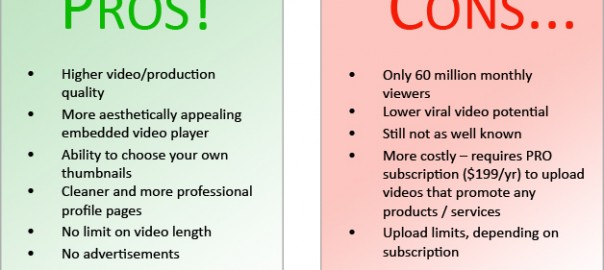
If you’ve been reading up on your digital marketing blogs, you’re likely to have come across the seemingly unending debate over which video host tops the online marketing totem pole. What’s most effective for B2B content marketing? What looks the best? What will provide the greatest ROI? In the end, it boils down to two major platforms – video search engine giant YouTube and contemporary up-and-comer Vimeo.

Regardless of the platform, online video marketing is rapidly increasing its reach and influence. According to a 2015 infographic created by Hubspot, 75% of business executives watch work-related videos at least weekly. In order to maintain a competitive edge, it’s a wise strategic play for B2B companies to jump on the video marketing bandwagon.
But then, the question is:
How does a B2B company decide between using YouTube or Vimeo?
Pros and Cons of Vimeo and YouTube for B2B Content Marketing Each of the two video hosts has its distinct advantages and disadvantages. But first, let’s consider what every B2B marketer should be keeping in mind when designing video content and choosing the right platform. Below are three priorities that should be at the top of the checklist.
- Audience – To whom are you marketing your business? How can you optimize your view count? What kind of interaction would you like with your viewers? Remember you are facilitating a relationship with your audience. Simplify accessibility to your website, and keep all communication both relevant and motivating.
- Quality – Not only is it important to promote your business with quality content, but production quality is also essential. What types of visual aids have you incorporated? Can your player handle videos of multiple types? Is high definition supported? Be sure your professionalism still comes across while you maintain a strong web aesthetic.
- Purpose – What is your ultimate end goal? Will your video be used as a product demo for prospects? Do you simply want to embed the video into a blog, or are you shooting for viral video status? Consider the response you are looking for and what action you would like your audience to take.
Now let’s take a good, hard look at our two competitors, YouTube and Vimeo, without losing sight of these three video marketing components. First up on the chopping block is YouTube!
Over the past decade or so since YouTube’s inception, the video host has creamed the competition in terms of viewership, having reached over a billion unique users, with over 4 billion daily views! In fact, there are 46,296 YouTube videos being viewed around the world every second. Only trailing Google itself, which acquired the website in November 2006, YouTube is now the second largest search engine on the planet.
Having become a household name through its launching of countless viral videos, YouTube has some serious potential to breed a great PR campaign. In addition, its favorable relationship with Google increases its SEO impact.
Unfortunately, what the platform boasts in audience reach and internal account customizability, it lacks in external control. Typically, viewers must subject themselves to random ads before they can even begin watching your videos. Similarly, a selection of other uploads is displayed alongside your own, and there is no solution for managing the content or quality of these adjacent files.

YouTube’s smaller yet more fashionable challenger Vimeo has been described as a community for more artistic editors and filmmakers, deemed by some of its growing audience as the counter-cultural alternative to YouTube. The platform’s organized layout, user-friendly search, simple aesthetic, and touch of sophistication renders the site more like a professional portfolio as opposed to a compilation of stacked DVDs. Though YouTube is still the dominant go-to (for roughly 94% of marketers), about 51% of marketers deploy their content via Vimeo, as well.
Vimeo’s major strengths lie in its design and quality. The host’s more streamlined video production features and higher HD compatibility make it a great choice for more serious endeavors requiring better resolution through a sleek embedded player. The player’s design also highlights content without focusing on any sort of Vimeo branding. And what’s more, there are no limits on length of time (unlike YouTube’s 15-minute cutoff), and perhaps more importantly, viewers aren’t bombarded left and right by advertisements.
The big HOWEVER is that Vimeo only has about 100 million unique monthly visitors, lowering its viral-potential and overall reach. And though it may not be an issue for some companies, a Vimeo PRO subscription ($ 199/year) is required in order to upload any video content that promotes products or services. YouTube, in turn, doesn’t charge.

So which is the better option for a B2B company with all these variables to consider? Think back to those three key factors in determining your video marketing strategy: audience, quality, and purpose.
Your audience should be as wide as possible, but B2B companies should have targets in mind – namely, other businesses. What kind of site will attract your target organizations? YouTube unquestionably provides an opportunity for broader viewership with top brands averaging 884,000 monthly views. Although Vimeo draws fewer sets of eyes, you have less competition, so it may be the more appropriate outlet, depending on your industry.
In terms of quality and production value, Vimeo may have the leg up. Its more refined vibe and approach to video hosting can be more appealing to professionals, a definite positive for B2B outreach. YouTube’s limit on video length is problematic for longer demos, but in the B2B marketing world, the average effective video lasts just 30 seconds to 3 minutes. Fully customizing your account may be more valuable than high resolution and unlimited duration.
Last but certainly not least, the end goal of your video marketing plan must be established in order to make a solid platform decision. YouTube’s SEO and viral video strengths may be the right choice if you are looking to mass market your content, products, or services. Vimeo’s quality design could be advantageous if you are aiming to link video content with blog posts and web pages.
Ultimately, the choice between YouTube and Vimeo is unlikely to be detrimental to your video content marketing strategy. A combination of both may turn out to be the best solution. It’s just important that B2B marketers analyze the nuances of their brands and what they are trying to achieve, and then optimize their strengths through the best channel possible. And above all, the key to successful video content marketing is to integrate it throughout your social media presence!
Digital & Social Articles on Business 2 Community
(365)







